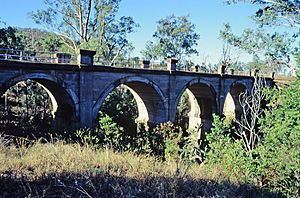Humphery Railway Bridge facts for kids
Quick facts for kids Humphery Railway Bridge |
|
|---|---|

Humphery Railway Bridge, 2002
|
|
| Location | Mungar to Monto line, Humphery, North Burnett Region, Queensland, Australia |
| Design period | 1900 - 1914 (early 20th century) |
| Built | 1913 |
| Architect | William Pagan |
| Official name: Rail Bridge (Humphery) | |
| Type | state heritage (built) |
| Designated | 21 October 1992 |
| Reference no. | 600518 |
| Significant period | 1910s (fabric) |
| Significant components | pier/s (bridge) |
| Lua error in Module:Location_map at line 420: attempt to index field 'wikibase' (a nil value). | |
The Humphery Railway Bridge is a historic railway bridge located in Humphery, Queensland, Australia. It was built in 1913 and is part of the Mungar to Monto railway line. This bridge was designed by William Pagan, a very important railway engineer. It is now listed on the Queensland Heritage Register because of its special history and design.
Contents
Building the Railway Line
The Humphery Railway Bridge was one of the last bridges built on this railway line. It was finished in 1913. People had wanted a railway link from Maryborough to Gayndah since the 1860s. However, construction didn't start until the late 1880s.
Connecting Towns by Rail
The railway line opened in stages. It reached Brooweena in 1889 and Biggenden in 1891. The line finally reached Gayndah in December 1907. This helped connect these towns to bigger cities and ports.
Later, in 1910, there were plans to extend the railway even further. Work began in 1911 to connect Gayndah to Mundubbera. The line reached Boomerang in November 1913 and Mundubbera in February 1914. The railway was extended again in the 1920s, finally reaching Monto in 1928.
A Special Bridge Design
The Humphery Railway Bridge is unique because it uses concrete arches. This was a new and special way to build bridges at the time. Queensland and South Australia were some of the first places to use concrete arches for railway bridges.
Pioneering Concrete Bridges
The very first concrete bridge in Queensland was built in 1897. Between 1900 and 1913, six concrete arch railway bridges were constructed in Queensland. Many people believe that William Pagan, who was the Chief Engineer of Railways, designed these bridges.
Early concrete bridges, like Swansons Rail Bridge, looked similar to stone bridges. However, later designs, such as the Steep Rocky Creek Railway Bridge (1906), were more modern. They used wall-type arches to support the railway track. The Humphery Bridge uses a similar advanced design.
What the Bridge Looks Like
The Humphery Railway Bridge is a concrete arch bridge. It crosses a dry gully about 2.8 kilometres (1.7 miles) southwest of Humphery Station. The bridge has five rounded arch sections. These arches support solid concrete walls, called spandrel walls.
Unique Features of the Bridge
Even though it's a simple bridge, it has nice details. It has projecting cornices (decorative ledges) at the bottom of the arches. There are also pillars above the piers (the supports between the arches) that extend above the deck (where the railway track sits). The spandrel walls are set back slightly, giving the bridge a textured look.
The bridge carries a single railway track that is 3 feet 6 inches (1067 mm) wide. The arch sections vary in size, with some being 7.9 metres (26 feet) long and others 10.7 metres (35 feet) long. The total length of the bridge is 42.9 metres (141 feet). The railings on the bridge are made of metal tubes between concrete pillars.
Why the Bridge is Important
The Humphery Railway Bridge was added to the Queensland Heritage Register on 21 October 1992. This means it's a very important historical site.
Showing Queensland's Development
This bridge helped the railway cross a deep gully. It shows how Queensland grew by connecting important inland towns and resources with ports. It also shows how skilled engineers used new technology to build railways in difficult areas.
A Great Achievement in Design
The Humphery Railway Bridge was built with a very creative design. It used reinforced concrete arches, which was quite new at the time. It was only the second bridge of its kind in Australia and the seventh concrete bridge in Queensland. It was also the last in a series of important concrete arch bridges built for Queensland railways between 1900 and 1913.
Connected to a Key Engineer
The bridge is a great example of the work of William Pagan. He was the Chief Engineer for Railways and played a big part in the early history of engineering in Queensland.

